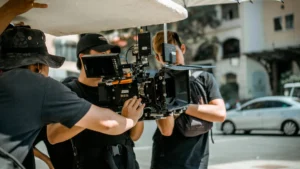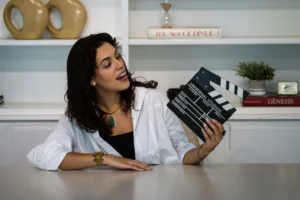What is treatment in filmmaking?
An Introduction for Novices
Filmmaking is a craft that needs structure as much as imagination. Every great film has layers of development and preparation behind it that the ordinary observer usually ignores. Among the most important instruments in this stage of development is the “treatment.”
If you are fresh to screenwriting or filmmaking, the idea of a treatment might seem abstract or perplexing. Still, it is among the most fundamental building pieces in the narrative process. We will define what a film treatment is, why it’s important, what it comprises, and how to properly compose one on this site. We will also address some of the most often-asked questions to get you going.
What in Filmmaking is a treatment?
A film treatment is, all things considered, a prose-style synopsis of your film or TV program concept. Mostly utilized in the development phase, this paperwork describes the project’s general concept, plot, characters, and tone. See it as a blueprint rather than as exact as a script; it is more evolved than a pitch.
Depending on its goal and the intended reader, a treatment usually written in the present tense may run from one page to thirty pages. Although there is no one correct structure, it commonly comprises:
- title
- One-sentence overview of the tale, the logline
- Synopsis, often known as a plot summary.
- Characters and their arcs, main ones
- Optional visual or artistic remarks
Before devoting time or money to your tale, the treatment assists producers, investors, directors, or manufacturing businesses to grasp its core.

Why is a treatment necessary?
- Visual Clarity
Writing a treatment requires the author or filmmaker to condense the tale. It clarifies uncertainty and lets one concentrate on topics, story structure, and character development.
- Pitch Tools
Before they want a complete script, producers and studios sometimes want to see a treatment. It’s a great instrument for a succinct and appealing presentation of your thoughts.
- Creative Direction
Throughout the writing and pre-production stages, a treatment serves as a creative north star. It guides directors, writers, and even performers toward the original concept.
- Aid for Development
Early in the process, it might assist in finding weaknesses, gaps, or undeveloped characters, thereby saving time during scriptwriting and production.
components of a good treatment
Though the shape is flexible, a powerful treatment usually consists of the following components:
1. Logline and Title
Beginning with your project’s working title, then include a logline—a one-sentence narrative summary that catches the main conflict or hook. “A young hobbit sets out on a perilous journey to destroy a powerful ring before it falls into the hands of an evil overlord,” says one.
2. Synopsis or Synopsis
This part is a synopsis of the main concept of the narrative. In one or two paragraphs, you may emphasize the genre, tone, and main story arc.
3. Principal Figures
Present your main characters along with their motives. Add to their development or change over the narrative—that is, the character arc. Steer clear of too much information; make it succinct yet instructive.
4. Plot Divide-down
The therapy revolves around this. Ideally split into three acts, it should move the reader through the narrative from start to finish:
- Act I (Set): Present the world, people, and the instigating occurrence.
- Act II (Confrontation) illustrates the conflict’s escalation, including significant turning moments.
- Describe how the battle ends and what the characters’ results are in Act III (Resolution).
5. Stylistic References (Optional)
The visual tone, cinematography technique, timing, or original directorial vision may all be covered in this part. For instance, you could want to note that, like Quentin Tarantino’s work, the narrative employs non-linear storytelling or extremely stylized images.
Approaches of Therapy
Different therapies exist depending on the objective:
1. One to two-page short treatment
Applied for first pitches or for fast concept presentations. Emphasizes the major characters and central narrative.
2. Long treatments—five to thirty pages
More thorough and usually used in cooperation with production businesses or studios. It painstakingly covers the storyline, character arcs, subplots, and even visual remarks.
3. Shooting Approach
Directors or cinematographers often create this version using technical considerations such as camera angles, lighting, or color pallet ideas.
Writing a Film Treatment: Techniques
This is a detailed instruction on creating your first film treatment:
- Beginning with a compelling logline will help to define the tone and grab readers’ attention.
- Write a brief overview of the genre, tone, and narrative subject.
- Create a profile of your characters, including their motivations.
- Plan your story using the three-act structure to dissect it.
- Keep the language visual and active; write in the present tense and make detailed descriptions of your tool.
- Review and polish your work before sending it to business experts; get comments from reliable colleagues.
Treatment Snippet Example (for reference)
Title:
Resonances of the Past Logline:
Discovering he is repeating the same day over and again, each time exposing a deeper layer of a repressed memory potentially saving his family, a devastated war veteran finds solace.
James, a former military man with PTSD, wakes up every morning feeling as if he is living another life. His world starts to break apart as he finds bits of a secret history. E very loop discloses a mystery that drives him toward a terrible reality about his previous assignment.
Names:
- James: Protagonist; very imperfect yet brave.
- James’s separated wife, Anna, had emotional hints about his memory.
- Ellis, the therapist, has a secret motive.
- James moves back to his hometown and starts to feel time loops. H gets in touch with Anna again; she notes his irregular conduct.
- James begins looking at the loops, which highlight memories from his service tenure that he had buried. As the truth approaches, he and Anna’s tensions grow.
- Act III finds him facing Dr. Ellis, who turns out to have altered James’s memories. James decides in a last confrontation that breaks the cycle and starts his road to rehabilitation.
Five Questions on Filmmaking Treatments
1. One should ask how long therapy should last.
Its intended use will determine this. Two pages will cover a basic pitch. The standard for in-depth development is five to thirty pages.
2. Would you get therapy before penning a script?
Highly recommended. Early, the identification of problems and organization of your thoughts are made possible by a treatment that saves time during scriptwriting.
3. Does a treatment match a synopsis exactly?
Not at all. Usually a one-page overview of the story, a synopsis is not as thorough as a treatment, which incorporates tone, structure, and character arcs.
4. Do cognitive therapies include communication?
Usually not. Treatments omit direct speech and are written in writing. For a dramatic effect, however, a few brief lines of conversation may be added.
5. Who reads film treatments?
Directors, writers, producers, financiers, and development executives. It’s a means of presenting the central concept and winning over interested parties.
Thoughts on Final Matters
The narrative link between your concept and a complete screenplay is a film treatment. Whether your job is producer, director, or screenwriter, learning the craft of creating treatments can help your pitch and narrative success considerably improve. I set the foundation for a strong cinematic vision, motivate confidence, and force clarity.
Make treatments your closest friend if you really want to join the field of filmmaking; they are not only a creative tool that may transform your vision into a visual masterpiece but also a necessary instrument in the business.
